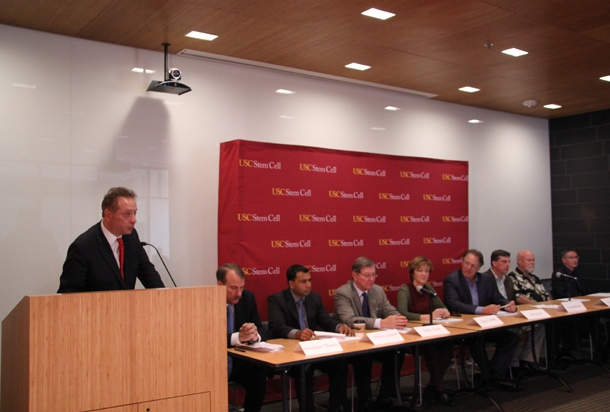Few 10-year-olds have brought 10 potential medical treatments into clinical trials. The California Institute for Regenerative Medicine (CIRM) is an exceptional 10-year-old, however.
In 2004, the voters of California created CIRM to dispense $3 billion to fund stem cell research in the state. This year alone, CIRM funding is expected for 10 projects for clinical trials, including ones based at USC.
To celebrate this milestone, CIRM held an event Nov. 20 at the Eli and Edythe Broad CIRM Center for Regenerative Medicine and Stem Cell Research at USC. This facility would not exist without funding from CIRM, noted Carmen A. Puliafito, MD, MBA, dean of the Keck School of Medicine of USC.
Puliafito added: “With this funding, our researchers — and researchers in 11 other facilities throughout the state — gained dedicated space to hunt for cures for some of the most pernicious diseases in the world, including heart disease, stroke, cancer, diabetes, Alzheimer’s disease and Parkinson’s disease.”
Jonathan Thomas, PhD, JD, chairman of CIRM’s governing board, called the stem cell agency’s first 10 years “a most exciting and historical time in medical research.”
Cedar-Sinai’s Dhruv Sareen, PhD, praised CIRM for creating a new industry in the state: “What Silicon Valley has done for technology, CIRM is doing for stem cell research in California.”
ViaCyte’s Eugene Brandon, PhD, described the company’s clinical trials with a small implantable device containing stem cells to treat type 1 diabetes.
City of Hope’s John Zaia, MD, mentioned his collaboration with Sangamo BioSciences on a CIRM-funded HIV/AIDS clinical trial. CIRM also funded the development of a technique for genetic modification of blood-forming stem cells to cure HIV/AIDS, pioneered by Zaia, City of Hope’s David DiGiusto, PhD, scientists at Sangamo BioSciences and USC’s Paula Cannon, PhD.
Zaia credited CIRM with creating a “climate of research that is relatively product- and milestone-driven.”
The head of USC’s department, research center and university-wide initiative in stem cell biology and regenerative medicine, Andy McMahon, PhD, FRS, underscored the importance of this HIV/AIDS trial. He also mentioned other USC-led clinical trials that are exploring stem cell-related treatments for Alzheimer’s disease, the dry form of age-related macular degeneration, knee osteoarthritis and immune damage from chemotherapy.
“I’m personally very excited and hopeful about the future of stem cell research in California,” he said. “The public support of our work through Proposition 71 has enabled our own researchers to spearhead important new research programs and to develop new therapeutic approaches. But just as important, CIRM funding has brought together powerful, cross-institutional teams that have united research around the goals of regenerative medicine to treat a host of diseases affecting humanity.”
Gay Crooks, MBBS, professor and co-director of the Eli & Edythe Broad Center of Regenerative Medicine & Stem Cell Research at UCLA, reported how CIRM-supported clinical trials have benefitted 18 children with “bubble baby disease.”
Fred Lesikar from Menifee, CA., shared his story of suffering a heart attack and then enrolling in a stem cell-based clinical trial, which seems to have improved his health.
“It’s not just patients who benefit from these treatments, families do, too,” said Lesikar.
The last word was left to Bob Klein, who led the drive to create CIRM: “The genius of the people of this state is reflected in their commitment to this cause,” he said, “and we should all be eternally grateful for their vision in supporting research that will save and transform people’s lives.”
— Kevin McCormack and Cristy Lytal


